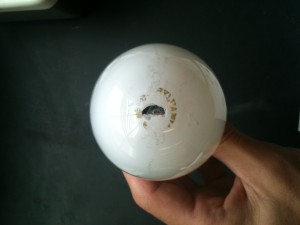In order to use a light bulb to illuminate the inside of a vacuum chamber, I needed to release the gas contained within the bulb else it would likely have exploded the bulb when the external pressure was reduced. However, I wanted to keep the glass intact in order to protect the fragile filament from my clumsy hands and to provide that soft white glow.
I first tried scoring and breaking only a small piece of the bulb, but that always resulted in an uncontrolled cracking/shattering of the entire bulb. The best suggestion I found on the internet involved using a CO2 laser to make the hole. That would probably work, but I’ll save building a CO2 laser from scratch for another day. Other suggestions typically involved drilling under running water at very low speeds with a very sharp drill bit. Since both patience and drills were in short supply, I tried another method.
I found that by using a metal file at a tangent to the glass, one can very slowly thin the glass in a relatively small area. In my experience, eventually the thinned glass breaks away leaving a small hole. The hole isn’t round and doesn’t form in an absolutely controllable way. Perhaps it may be possible to “punch” a smaller hole after thinning the glass but before it breaks.


Wondering how successful you were. Because, the way a bulb is designed, it keeps the filament from instantaneously igniting and ruining the bulb.
A better solution would’ve been to modify your vacuum chamber to accept a port that would allow a bulb to shine light from the outside. But make sure the port is inserted and sealed from the outside. So when you draw the vacuum, the port will seal shut, rather than pull open.
Hi Ed,
The bulb worked well in this application. Cheap incandescent light bulbs are usually filled with a mixture of nitrogen and argon. The gases prevent oxidation of the filament (if air were used instead) and slow the evaporation of the tungsten filament. Inside the vacuum chamber, under vacuum, there is no oxygen and oxidation is not a concern. The filament cannot ignite. For sure, evaporation of the filament was happening at a higher rate and the lifetime of the bulb was shortened. Still, the bulb lasted the next couple of years while I needed it.
The vacuum chamber could not be modified with new ports, unfortunately. Before the internal lightbulb, I was using a flashlight shown through the one top port with a sight glass. I found this was inadequate. The light never seemed to illuminate the areas I needed to see, and it was hard for both my eye and the flashlight to look through the sight glass at the same time. Thanks for the suggestion though.